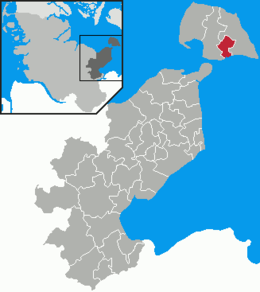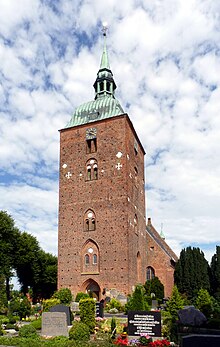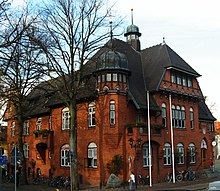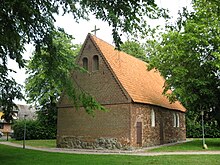Castle on Fehmarn
|
Castle on Fehmarn
City of Fehmarn
|
||
|---|---|---|
| Coordinates: 54 ° 26 ′ 19 ″ N , 11 ° 11 ′ 51 ″ E | ||
| Height : | 11 m | |
| Residents : | 6000 | |
| Incorporation : | January 1, 2003 | |
| Postal code : | 23769 | |
|
Location of Burg auf Fehmarn in Fehmarn |
||
Burg auf Fehmarn ( Low German : Borg up Fehmarn , Danish: Burghæby) is the central district of the city of Fehmarn . The small town was independent until 2003. The place is on the island of Fehmarn in the Ostholstein district in Schleswig-Holstein . The population is about 6000.
coat of arms
Blazon : "In silver over alternating silver and blue waves, a free-standing red castle made of bricks with a crenellated wall, closed golden gate and two blue-roofed tin towers, each with two arched windows, between which the red Holstein shield with the silver nettle leaf floats."
This coat of arms was adopted by the city of Fehmarn.
history
Burg was first mentioned in the Waldemar- Erdbuch in 1202 as Borch up Vemere , and in 1599 the place was first referred to in New High German as Burgk uff Femern .
From 1230 to 1250 the church of St. Nikolai in Burg was built.
One in the Middle Ages -scale harbor near the village silted up in the 15th century. He was protected by the heavily fortified Glambek Castle . It was not until 1857 that a new port was created in the Burgstaaken district of Burger . A district court was established in 1867 and existed until 1976. From 1896 regular shipping with the steamers Fehmarn and Meta to Lübeck and Kiel was taken up.
In 1787 a major fire destroyed 21 houses.
On January 1, 2003, the city of Burg auf Fehmarn merged with Bannesdorf auf Fehmarn , Landkirchen auf Fehmarn and Westfehmarn to form the city of Fehmarn . The whole island of Fehmarn now consists of just one city.
Population development
In 1552 the castle had 1,060 inhabitants, a good 100 years later in 1661 there were 1,300 inhabitants. In 1724 only 973 inhabitants were counted. In the first bloom of the tourist office in 1908 the population was 2881. Today there are about 6000 inhabitants, in addition there are more than three thousand guests in the high season.
The port of Burg on Fehmarn
The town of Burg is not located directly on the sea, but is separated from the haff-like Burger Inland Lake by a strip of land that is almost two kilometers wide.
The first port of Burg was located directly on the western edge of the city and was connected to the Burger Binnensee by a natural channel, the Seegen ditch . This old city harbor silted up and was abandoned in the early 15th century. For this purpose, a new artificial harbor was built on the spit in front of the inland lake. This port, called Dat Nye Deep , is protected by stone box dams. In a contract between the city of Burg and the Fehmarn region in 1557, both parties undertook to jointly maintain the port facility, in particular the mole-like protective bulwark.
During the Thirty Years War , the port on the New Depth suffered considerable damage from Swedish invasion troops. The port did not recover from this. The next two centuries were marked by multiple attempts to repair the port. The condition of the port is based on a letter from the citizens and skippers to Burgk from 1650 to the king asking for support in the repair of the port, in which they stated that:
- Our Burger Depth and Schiffshaffe, not only from those soldiers who had just quartered their Kortegarde next to them, miserably spoiled on bulwarks, especially now so muddy and covered with sand that no boat, let alone a barge, can come in and out of it, whereby our food , while lying in front of the Reide is extremely dangerous, but is swamped and very depressed.
Since the middle of the 18th century, a place on the north side of the Burger Binnensee has been used as a port. This port, known as Stacken , has also been used by the ferry boats between Fehmarn and Lolland since 1778 . Today it is Burgstaaken .
Leisure and Tourism
- The Fehmarn Marine Center with the largest shark tank in Germany is located in Burg auf Fehmarn (as of 1998). In addition, silo climbing is carried out on a former 40 meter high silo . In addition to an indoor kart facility, there are surf and kite schools and riding stables in Burg.
- In 2002, Burg auf Fehmarn was one of the ten most important places for tourism in Schleswig-Holstein . 47,704 guests, 1,476 (3.0%) of them from abroad, booked 312,115 overnight stays. The place had 3364 guest beds.
- On the south beach there is a large holiday complex with holiday apartments, beach and restaurants.
- Apart from St. Nikolai , Burg has other sights to offer, such as: For example, the medieval St. Jürgen Chapel , which was part of a medieval "infirmary", well-preserved town houses from different centuries and a picturesque market square with the town hall, inaugurated in 1901, an impressive brick building, and the Galileo Wissenswelt museum .
- The Ernst Ludwig Kirchner Association e. V. runs an exhibition in the town library of Burg on the artist's stays in Fehmarn in 1908 and 1912–1914.
traffic
In 1905, Burg was connected to the railway network by the Lütjenbrode – Orth small railway . The Burg station was operated by passenger traffic until 1983 and freight traffic until 1994.
Fehmarn-Burg station was opened on July 31, 2010 . This is located directly north of the former train station on the reactivated railway line. The realization of these plans suffered a brief setback when the residents turned against the financing of the design of the station forecourt in a referendum. As a result, the entire project seemed to fail. Since August 1, 2010, Burg has again been directly connected to regional and long-distance traffic via the Vogelfluglinie . Lübeck and Burg are connected to each other every two hours and since December 2010 Burg has been served by a single Intercity to Cologne .
Others
Some farms still exist in Burg, but they are now in the middle of residential areas, as the city has expanded around them over time.
sons and daughters of the town
(Sorted by year of birth)
- Marten Pechlin (1480-1526), pirate
- David Gloxin (1597–1671), mayor and diplomat of the city of Lübeck
- Balthasar Gloxin (1601–1654), lawyer and ducal councilor
- Otto Gibel (1612–1682), music theorist, composer and teacher
- Christian Kortholt the Elder (1633–1694), theologian
- Christian Münden (1684–1741), Evangelical Lutheran theologian and pastor
- Johann Horkel (1769–1846), physician and botanist
- Amalie Schoppe (1791–1858), writer
- Benedikt Niese (1849–1910), classical philologist and historian
- Charlotte Niese (1854–1935), writer, local poet and teacher
- Hans Ruser (1862–1930), captain and polar explorer
- Wilhelm Mildenstein (1870–1933), Lutheran clergyman
- Hans Bielenberg (1883–1970), administrative lawyer and municipal official
- Friedrich-Wilhelm Lucht (1905–1975), lawyer and politician (SPD)
- Hans Muxfeldt (1927–1974), chemist and professor
- Diether Trede (1932–2008), football player
- Jürgen Blin (* 1943), heavyweight boxer
- Bernd Lau (1943–1992), radio play director
- Manfred Matusza (* 1944), economist, university professor and former local politician (CDU)
- Irmgard Riessen (* 1944), theater and television actress
- Horst Zielske (* 1946), photographer
- Bernd Thiele (1956–2017), football player
- Peter Ott (* 1966), filmmaker and film producer
- Axel Hager (* 1969), volleyball player
- Dirk Weetendorf (* 1972), former soccer player
Web links
swell
- ↑ Schleswig-Holstein's municipal coat of arms
- ^ A b Ewald Höpner: Fehmarndörfer
- ^ StBA: Changes in the municipalities in Germany, see 2003
- ↑ Territorial change agreement
- ↑ LVS route blog. (No longer available online.) Formerly in the original ; Retrieved August 8, 2010 . ( Page no longer available , search in web archives ) Info: The link was automatically marked as defective. Please check the link according to the instructions and then remove this notice.
- ↑ http://www.bahnnews.info/aktuelles/berdez10.htm#fehmarn









